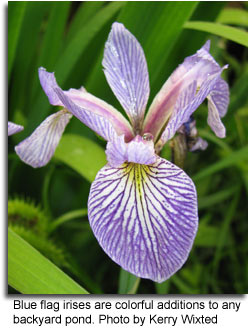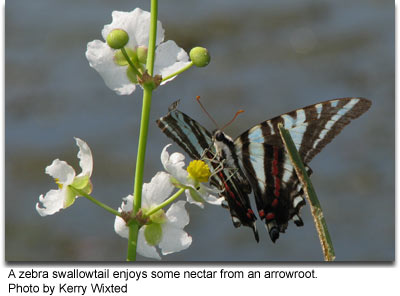Water is an essential component for life and a basic need for any backyard wildlife habitat. If you have the time and space, then consider adding a backyard pond to your habitat to attract a variety of wildlife from birds to dragonflies! A backyard pond can consist of a shallow pool that generally caters to birds, or it can be a larger, deep pond complete with plants and variable water depths. The larger the pond, the greater chance you have at attracting the most diversity of wildlife.

Before You Begin
In some areas, laws dictate how a pond should be built and indicate liabilities in case of accidents. Check your local ordinances or consult your county or city government offices for an interpretation of existing laws before building your pond.
Pond Planning
The first steps in designing your backyard pond are to figure out how big you would like it to be, and where it will go. Ideally, ponds are best placed in areas that get at least 5 hours of sunlight each day. However, it is ok for the pond to receive more sunlight or for it to be in a shaded area. It should be noted that ponds under tree cover tend to get more leaf debris which should be removed before it decays. Often times, decaying leaves will remove oxygen from the water. Another thing to consider is the possibility for run-off. Don’t place ponds in areas with lots of run-off unless you want it to fill up with sediment. If you want a water source in an area with run-off, then consider constructing a rain garden to trap water and run-off instead of building a pond.
Once you have an area picked out, the next steps are to outline and excavate! Take some stakes and strings to outline the desired area of the pond. If you are using a pre-formed liner, then be sure to outline the pond based on the liner’s shape. Feel free to be creative with your pond shape! When the area is outlined, it is time to excavate. If you are planning on putting in a deep pond (over 1.5ft), then try to excavate some shallow areas along the edges of the pond that have a depth up to 3 inches. A gradual increase in pond depth will help amphibians and other animals access the area. These “shallow shelves” are also ideal for pond plants which generally shouldn’t be planted in areas over 2ft deep. Sometimes, instead of adding shallow areas, you can include partially submerged logs or rocks in the water to assist certain critters. Shallow areas are best situated in shady areas as shallow areas can heat up relatively quickly in the sun, encouraging algae growth.
After your pond has been excavated, placing the liner in the pond is the next step. Liners can come in all shapes and sizes- from flexible liners to pre-formed ponds or recycled tubs and barrels. In areas where the water table is high, then a liner is not necessary. The liner should be large enough to overlap the pond edges by about one foot.
To calculate the size (length and width) of a liner required:
- Length = length of pond + (2 x depth) + 2 feet (1 foot overlap, each side)
- Width = width of pond + (2 x depth) + 2 feet (overlap)
To install a plastic sheet liner, spread it taut across the top of the hole and hold it in place with stones. Fill the liner slowly with water. The water will cause the liner to sag and mold to the form of the hole. Smooth the liner and fill to about three inches from the top. Wait about a week, and then cut the liner to about 6 inches past the edge. Cover the excess liner with soil and plant native plants around it.
To install a pre-formed pond or tub, place several inches of sand between the bottom of the tub and the floor of the hole to level the surface. Add water to determine if pool is level. If not, remove pool and redistribute sand. When level, fill the tub with water and let it stand for a week. If any settling occurs, fill spaces between the tub and the sides of the hole with soil.
Does Your Pond Need Pumps and Filters?
Small backyard ponds do not normally need pumps and filters, and they should not be emptied regularly. If you do want a pump, then place it in the bottom of the pond, slightly raised off the surface to prevent clogs. A small, reciprocating pump can create a “gurgling” noise that is attractive to many bird species. If you plan to have fish in the pond, then a pump and filter generally are necessary.
When your pond is well established, it may appear slightly green. This is normal algae growth. Excessive algae growth will be visible from the floating “fuzzy” green plant parts on the water’s surface. Adding fresh water to your pond occasionally should help prevent excessive algae growth.
Plants to Use in Your Pond
Plants in and around your pond are great additions that provide food, cover and nesting habitat for a variety of species. Some pond plants also help oxygenate the water. Keep in mind that no more than 65 % of the pond surface should be covered with plants during the summer months. This allows oxygen and sunlight to enter the pond. When adding plants in and around your pond, it is good to stick with mostly native species or non-aggressive non-native species. Several species of pond plants that are commonly sold and are invasive include parrotfeather (Myriophyllum aquaticum, M. spicatum), water hyacinth (Eichhornia crassipes, E. azurea), curly pondweed (Potamogeton crispus), water chestnut (Trapa natans), water lettuce (Pistia stratiodes), yellow iris (Iris psuedoacorus), flowering rush (Butomus umbellatus) and reed canary grass (Phalaris arundinacea). In lieu of invasive plants, try planting species from the lists below.

Emergent Plants
American water plantain
(Alisma subcordatum)
American water willow
(Justicia americana)
Arrow arum
(Peltandra virginica)
Arrowhead
(Sagittaria spp.)
Blue flag iris
(Iris prismatica, Iris versicolor
or
Iris virginica)
Bulrush (Scirpus spp.)
Bur-reed
(Sparganium americium)
Cardinal flower
(Lobelia cardinalis)
Cattail
(Typha spp.)
Monkeyflower
(Mimulus ringens)
Nodding beggar ticks
(Bidens cernua)
Pickerelweed
(Pontederia cordata)
Spikerush
(Eleocharis spp.)
White turtlehead
(Chelone glabra)
Wool grass (Scirpus cyperinus)
Floating Plants
Bladderworts
(Utricularia spp.)
Duckweed
(Lemna spp.)
Pondweed
(Potamogeton spp.)
Water lilies
(Nymphaeceae family)
Watershield
(Brasenia schreberi)
Yellow pond lily (Nuphar lutea)
Submerged Plants
Water celery
(Vallisneria americana)
Waterweed
(Elodea canadensis)
Establishing Plants
Depending on your pond structure, plants can either be planted directly in the pond or in containers. Planting vegetation in containers allows you to easily remove plants from the pond for thinning, replanting and protection from the cold. If your container extends above the water’s surface, then it can create great habitat for amphibians. A good planting mix for pond containers includes one-quarter sand, one-half garden loam and one-quarter compost. Be sure to avoid adding potting soils which have materials that float like perlite.
Aquatic Animals
Given time, your pond will be colonized by animals. The first animals to arrive will be insects like dragonflies, beetles and mayflies. Mosquitoes may also lay eggs in the water. To safely control mosquito larvae, consider using the natural
Bacillus thuringiensis israelensis (Bti) or
Bacillus sphaericus (B. sphaericus), two commercially sold pathogens. These natural pathogens kill mosquito larvae but do not harm people or animals other than mosquitoes. To learn more about these products, then visit the Environmental Protection Agency website on
‘Larvicides for Mosquito Control’.
Frogs, toads, salamanders and turtles may follow, with occasional visits from song birds and other small animals. If you intend to have amphibians to inhabit your pond, then do not add fish to your pond. Fish eat amphibian eggs, larvae and even small amphibians!

Cleaning Your Pond
Your pond should not need to be cleaned very often. Usually, it is best to clean the pond once a year in early spring. If you suspect chemical pollution or have observed a heavy growth of algae on the water surface, then you may have to clean the pond as well.
Steps for Cleaning Ponds
- Drain out half of the water by siphoning, dipping, or using the plug provided in the liner.
- In the case of pollution, drain all the water. This means removing all animals and plants. Store them temporarily in a tub
with de-chlorinated water while you drain and refill the water. - Annual spring cleaning involves partial draining and refilling so plants and animals can stay put.
- When cleaning, remove all plant debris. You may wish to divide, repot and fertilize plants.
- When refilling, add a de-chlorinator to keep the water safe for plants and animals. An alternative would be to let water
sit for at least 24 hours before adding plants and animals back into the pond.

Invite Wildlife to Your Backyard!
For more information, please contact:
Maryland Department of Natural Resources
Wildlife and Heritage Service
Tawes State Office Building, E-1
Annapolis MD 21401
410-260-8540
Toll-free in Maryland: 1-877-620-8DNR
[email protected]ov
Acknowledgements:
- Pond picture designed by Kerry Wixted with graphics from Tracey Saxby. IAN Image Library (ian.umces.edu/imagelibrary/)
- Blue flag iris picture and swallowtail picture by Kerry Wixted
- Bullfrog picture by John White